Avatar: the Last Airbender and Avatar: The Legend of Korra are two shows by Michael Dante DiMartino and Bryan Konietzko that we can’t seem to get enough of. The good news is, thanks to sequel comic series published by Dark Horse, there’s plenty of new material on the way.
The Avatar: the Last Airbender (ATLA) comics started coming out in 2012. This was especially welcome given that the series ended on a most frustrating cliffhanger:

The answer…may surprise you. But all in all, these comics are a fun way to jump back into the incredibly fulfilling Avatar universe. They also are able to cover more nuanced ground than the original series, or at least ground less reliant on action.
For instance, the first comic trilogy, The Promise, focused on the complex reality of dissolving colonies after many years of occupation. It’s not so easy to give back old land when new identities have formed for the residents. The execution, though not perfect, added a texture to our understanding of Republic City, the main location in which Legend of Korra (LOK) took place. Similarly, The Rift demonstrated how the Air Acolytes were formed as Aang’s way of keeping his culture alive, while also adjusting to the changing times (and loss of all other airbenders).
At the moment, we’re in the middle of the fifth comic trilogy of this series, North and South, the second volume having just been released a week ago. This one was a welcomed change; the first four focused on Aang and Zuko most explicitly (though Toph got her time to shine in The Rift as well), while Katara, who in many ways served as the heart of ATLA, was more on the sidelines. North and South centers on the conflict between the Northern and Southern Water Tribes, something explored by both series, and something Katara found herself directly in the middle of thanks to being the only waterbender in the South.
The thing is, like Rogue One, we know where this tale is going to end up, because we see the political and economic states of the Water Tribes in LOK, and how that (plus some Hamlet) leads to a civil war. That means that the story of the tribes getting from A to B needs to either be incredibly engaging, or incredibly challenging to our characters in some way.
The Background
As a quick crash-course in what the “A” and “B” are, at the beginning of ATLA, the two tribes are more or less separate. There are some cultural similarities since they all came from the North originally, but they evolved differently. The Northern Water Tribe are humorless jerks with arranged marriages, giant castles, a hereditary monarch, sexist workplace roles, and a close connection to the spirits. They even have a pond where two of them swim around. The South is egalitarian and has a council of Elders as their authority, greater gender equality, very tiny igloos, and a complete lack of knowledge about the spirits. Katara and Sokka didn’t even know they existed until one almost ate Sokka.
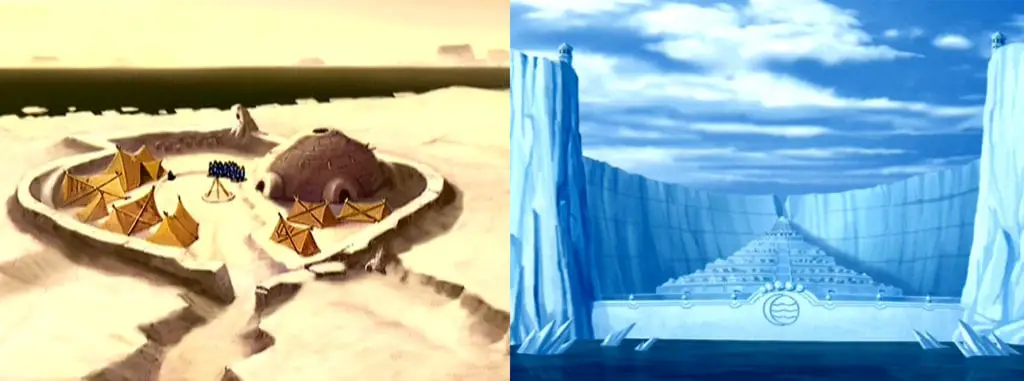
The Southerners are also more willing to sail about the world (some even left to go live in a swamp!), while the Northerners seemed more isolationist. Perhaps for this reason, or just because the South didn’t build many defenses, during the Hundred Years War, they were targeted for Fire Nation raids. Their villages were more or less destroyed, and all the men sailed off to go fight. The North, meanwhile, had a very big wall and were almost able to stay out of the war entirely until the very end. Which was the Gaang’s fault.
In LOK, we learn that the Southern Water Tribe is now technically governed by the Northern Chief, though they still have their own chieftains, and it feels very “in name only.” We also see that the tiny, decimated village became a booming metropolis called “Harbor City,” and one that feels like it’s very much globalized, to the chagrin of Chief Unalaq.
Unalaq: It’s a shame the Southerners have abandoned all connections to the spirits. Even during the most hallowed times.
Korra: I’ve always loved the Glacier Spirits Festival. It’s fun.
Unalaq: This festival used to be a solemn time of fasting and meditation. Now it’s just a chance to watch some rube try to stick an entire arctic hen in his mouth.
Bolin: (entire arctic hen in his mouth) What? Oh, it’s so good.
Tonraq: Traditions change. It’s not the end of the world.
Unalaq: Tell that to the sailors who are being attacked by angry spirits in southern waters.
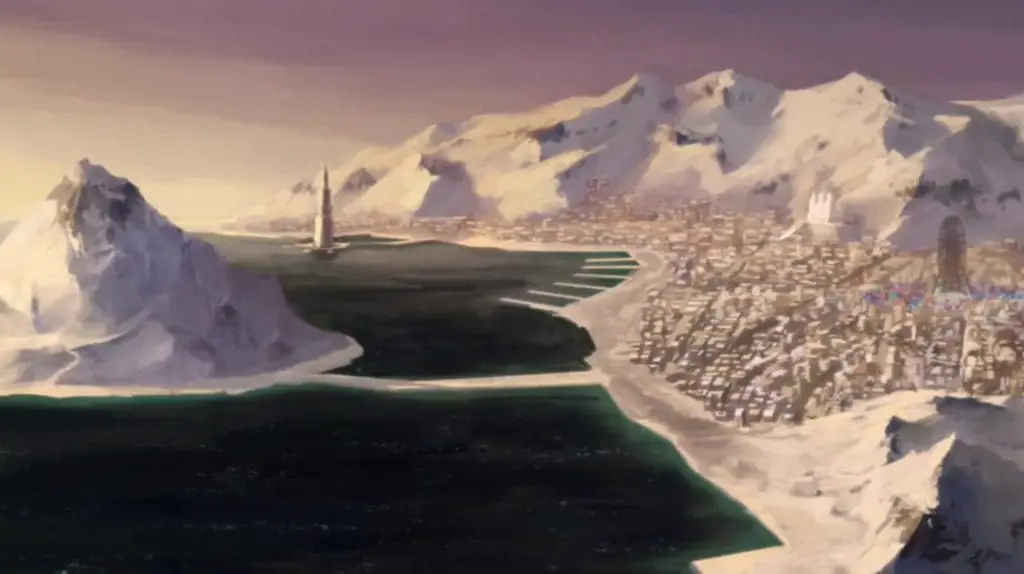
Really, it’s not hard to piece this together. It seems like after the Hundred Year War, the Northern Water Tribe helped the South to rebuild and grow, and many settled there. Probably in return, the South agreed to be ruled by the Northern Chief, as long as they could keep their own local laws. My guess is that they pay taxes to the North, but that’s really the extent of it. They’re still viewed by the world as two distinct tribes (the South even has its own cultural center in Republic City, as well as a seat on the Council), and the spiritual focus of the North clashing with the secular, globalized South suggests that the Southerners became more involved in international trade, while the North remained quasi-isolationist.
Unalaq: As your chief, it is my honor to speak at this festival, which was founded to bring our tribes together and restore the ancient balance between our world and that of the spirits. But I am saddened to see what it has become: a cheap carnival that celebrates greedy and trivial humans.
If that were the case, it kind of sounds like the North hadn’t checked in for some time…
It’s not that this is a bad tale to tell, especially since it involves the tension between the preservation of cultural identity versus global cooperation (I’m suddenly reminded of Pacific Overtures), which could weigh heavily on our protagonists.
Off to a decent start
It felt like North and South‘s first volume was putting us on this trajectory. Katara and Sokka arrive at their home in the Southern Water Tribe to find that there’s two developers (Malina and Maliq) from the North who have been designing buildings that more or less evoke their own tribe, rather than the South. Now, given that when they were last there, the one standing building was the igloo where they pooped, I’d have thought the rapid development of the South would have excited both Katara and Sokka. It did for the latter (he is nothing if not eminently practical), but Katara disapproved. Her discomfort worsened upon finding out that her father (Hakoda) had been made head-Chieftain and was having a palace designed for himself. Not to mention, she witnessed microaggressions on the part of the Northern developers he was working with.
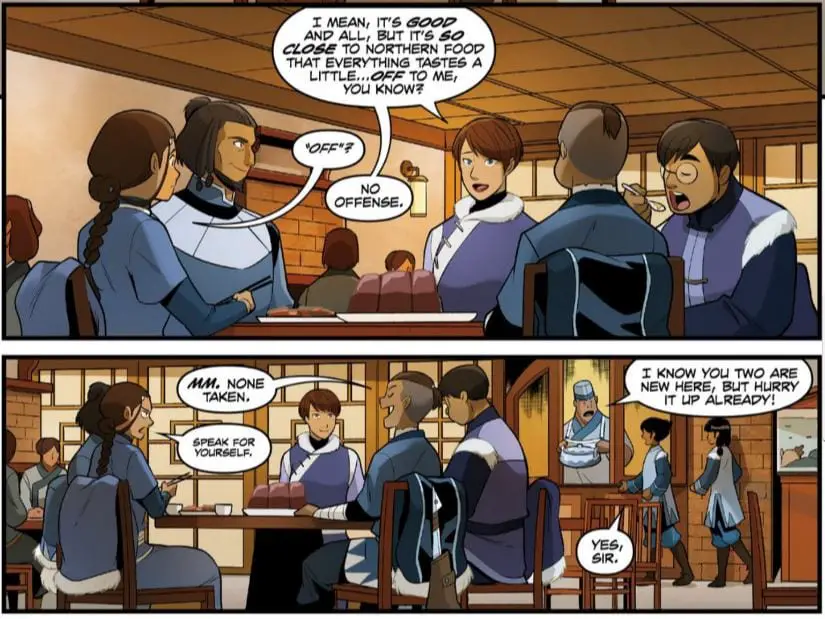
Remind you of anything?
Hahn: You’re just a simple rube from the Southern Tribe. What would you know of the political complexities of our life? No offense.
Later, Katara and Sokka stumble under an underground resistance of Southerners who don’t trust the Northern developers, and who feel that they’re imposing too much of their lifestyle onto them, including their laws; Hakoda’s promotion as the Most Important Chieftain is a piece of this, and remember, it was the North with the incredibly strict (and sexist) way of life. Katara and Sokka argue with Gilak, who’s leading this resistance, because they don’t like the suggestion that their father is failing to “see the truth,” but once they get back to their village, they learn that their dad is schtupping Malina.
Part 1 wasn’t perfect, especially since the guys arguing against cultural subjugation were framed as “too extreme” due to this:
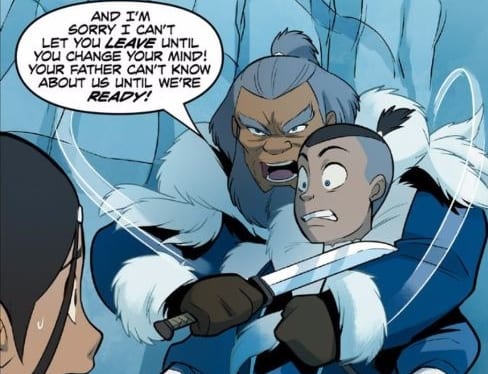
Which…isn’t exactly meant to full us with warm and fuzzies, but it’s hard not to see where he’s coming from.
To be fair, Katara did say as much, though she was mystifyingly coming from a place of pushing against progress and change in and of itself. Supposedly because of the events of The Rift, where the message was “progress can be balanced so that cultural integrity is preserved yet still adapted to the changing times.”
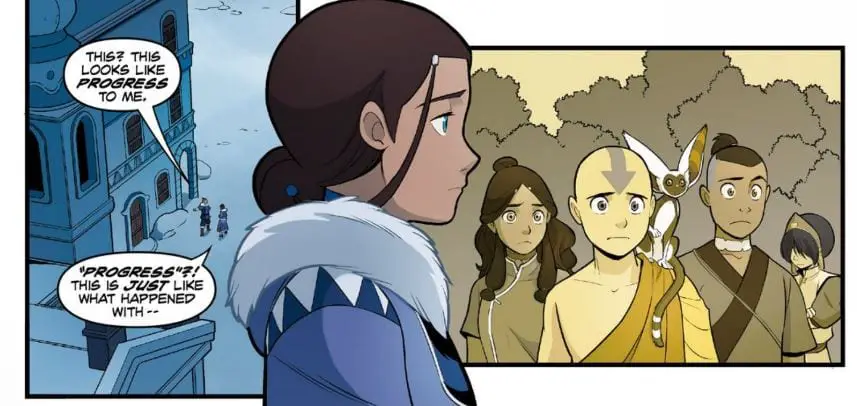
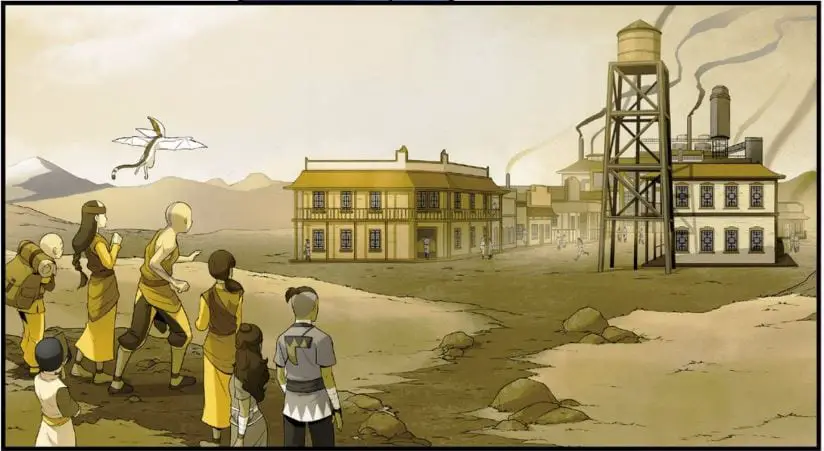
Short-term memory loss aside, this felt in contention with what we know of Katara, given that she’s more or less the embodiment of change (her element, too). Remember when she brought the North feminism? And she’d also be the person who would be happy to see the opportunity for her village to be lifted up, given that they had nothing at the start of ATLA. I guess being very generous, she associates any kind of progress with pollution, but A) we’re literally just talking buildings that aren’t igloos that she is objecting to, and B) unless she was stoned during the events of The Rift, we learn that industrial processes can be perfectly safe as long as they’re in the hands of the right person (that person being, of course, a Sato).
It felt a little like sticking a square peg in a round hole, a hole that we’ve already seen thoroughly explored through Aang in both The Promise and The Rift. Worse still, it felt like a missed opportunity given how LOK also failed to sink its teeth into the cultural conflict of the Water Tribes, and Katara would have been the perfect lens through which we could see this de jure Northern Rule take place.
And then…
Even with these gripes, I did think that a second volume could handle the topic well. Maybe Katara’s stance would have been clarified with a specific tie-in to how she views her culture, or maybe Gilak would be framed in a different light. There were plenty of opportunities. Unfortunately, it served more to muddy the waters and conflict with show-canon.
As a quick summary of what happens (FULL SPOILERS)…
Maliq explains that he and Malina found a huge oil deposit under the South, and part of the plan is to excavate with the help of the Earthern Fire Company of which Toph is now an official partner. So she pops in. Maliq is very pro-drilling because oil powers machines, and machines make nonbenders equal to benders. Sokka likes this too. Katara didn’t know nonbenders were at a disadvangtage. Hakoda, meanwhile, tries to track down Gilak. He’s bad at it. Everyone attends a festival that Maliq and Malina throw, and during it Katara tries to explain to her dad that she thinks Malina doesn’t really get the South and is worried about the development plan. Aang materializes on Appa for some reason, and Hakoda being nice to him makes Katara want to try to be nice to Malina.
Malina goes to give a big speech at the festival about how the South can “finally” make a presence on the world stage (they were the ones fighting the war, you ass), but everything changes when Gilak’s team attacks! Gilak announces to the crowd that the North plans on stealing the oil and literally colonizing them (they have proof since Maliq wrote this down on a piece of paper that he carries around with him), and for some reason the guy decides to happily own up to that.
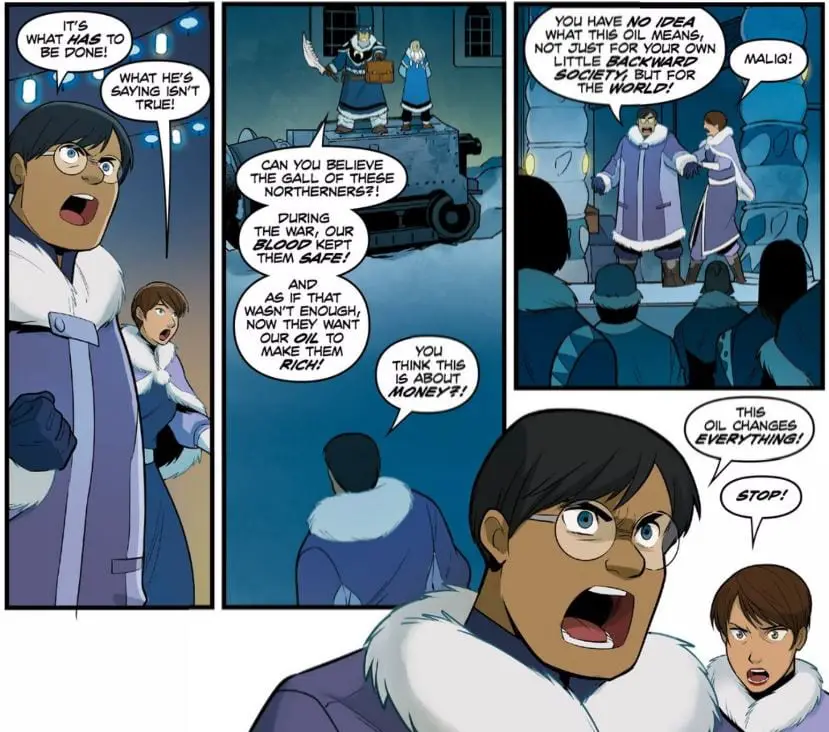
Gilak orders his people to attack Maliq and Malina even though she says they’ll just go, and Katara, Sokka, Aang, and Toph all try to protect them, because they “don’t deserve to die,” though Toph may have just been beating random people up. Gilak traps the Northerners in a net and almost kills them, but Hakoda stops him. He asks if they can chat, but Gilak stabs him Kylo Ren style. Katara does her thing, trapping Gilak in ice and saving her dad, who gets taken to Gran-Gran and Pakku’s love shack to recover. Gran-Gran thinks everyone is wack. Katara thinks the idea of removing oil at all is “crazy” because it will make the South forget who they are, Malina and her bro are shipping out so she goes to say goodbye to Hakoda, and a prison guard tells Gilak that he had a point.
Oppression, Colonization, Oil, and Identity
As with Part One, my biggest grievance is how out-of-character Katara feels.
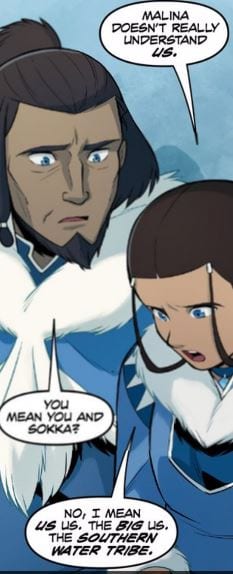
At the most, I could see her having reservations about the environmental impact of drilling. But that she’s just arbitrarily pushing against development and the opening of the South to the west on a global scale, especially after she traveled the world to save it, seems off.
It also really doesn’t help that her concerns about “forgetting who we are” are never contextualized by how she sees the South. Part One started off with her dreaming of how pretty her village looked after a fresh snow in a memory with her mother. So maybe it’s possible that the changes are making her feel more distant from her mother, and that’s what this is all about? If that’s the case, we could do with it explicated a bit more. Especially since the last time we saw the South, all they had was Sokka’s crumbling watchtower and some tents, so her reluctance sounds more daft than anything.
I did like Katara’s suspicions of Malina and Maliq. She’s intuitive and would have picked up on their vibe of superiority. However, we don’t see her object to the North stealing the oil, to the colonization, or even the way the Southern Water Tribe’s laws were being changed (again, Head Chieftain Hakoda is an issue given their egalitarian lifestyle). We just see her objecting to the broad concept of modernization.
Katara (during ATLA’s run): Gran-Gran wouldn’t let your [Northern] tribe’s stupid customs run her life. That’s why she left. It must have taken a lot of courage.
Not now, Katara!
I guess the final volume could clarify where Katara is coming from, but given that Aang went through this plotline in the comics twice, as well as on the show in “The Northern Air Temple,” it comes across as odd that she wouldn’t have taken in this lesson already. It also begs the question as to why this is the story we’re getting again.
Then we have the issue of canon. In LOK, the Southern Water Tribe was becoming increasingly globalized and secular in lifestyle, to the chagrin of the North. Having it be the Northern developers that want to “put the South on the map” given their own isolationism, and given that they’re the ones turning up their noses at that cheap and tacky festival, really makes little to no sense. I suppose it’s possible that Unalaq was alone in his spiritual focus up North, though Tonraq’s banishment over messing up a spirity forest indicates otherwise.
I could 100% see the developers trying to make buildings just like they have, or alter the laws to be more strict and “efficient,” as things are in the North. I could also see them sinking resources into these efforts, as well as sending benders down there to do so, since the South had basically nothing at the end of the war thanks to the work of the Southern Raiders. However, I don’t see how the LOK tensions make sense if Northerners were the ones encouraging the industrialization and putting on a tacky festival that looked pretty much identical to the Glacial Spirits. Did things get a lot more fun up north after the Gaang left?
I also don’t know why the plight of the nonbenders was tied to this at all. Maliq is right: nonbenders are at a major disadvantage in the world, even if Katara is magically unaware of this fact, and we see how they become the oppressed majority in Republic City due to this. Industrialization sort of does save their lives in some ways, at least in creating machines that can allow for their protection, as well as competition in the job market.
So of course there’s a value to the oil, and a general social good. Electricity is kind of a good thing too, and can allow people greater comfort in their lives. Keep in mind, Katara and Sokka were going out in a dinky little boat every day, hoping to catch one fish. Sometimes progress is nice.
Yet having this point about nonbender inequality coming from the mouth of the guy who is also advocating colonizing the South is…tone-deaf to say the least. I guess all the best colonizers have their justifications, but this opens up incredibly messy implications and lateral oppression. However, perhaps the idea was to introduce this concept of oil’s benefits, so that Sokka can follow-through on the implications in the final volume.
As a sidebar, Sokka is nearly perfect in this. I’m not even saying that due to his obvious flirting with Toph, but more that he is, to the core, that practical guy. People want to buy the oil? Why not let them do that, especially since there are benefits he’s already seen. Heck, Toph could probably even extract it without any disruption to the ecosystem. And given how he and the Gaang have been running around the world founding new nations and investing in industry, why would he be fighting this? I hope he can talk some sense into his sister.
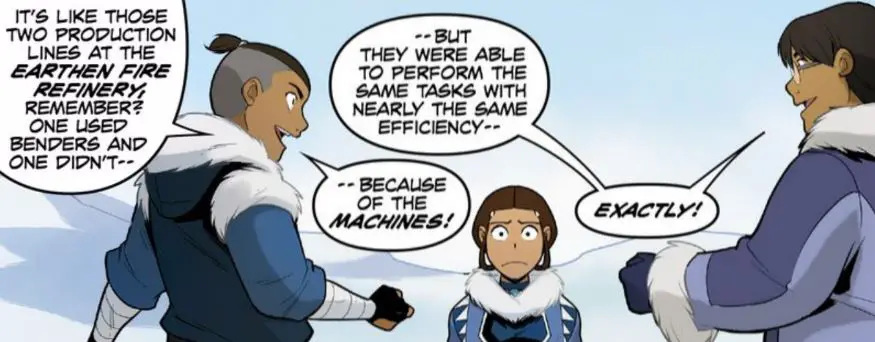
Finally, North and South stumbled with some black-and-white morality…something we’ve seen the Avatar franchise fall victim to before.
From what I can tell, Gilak is the primary antagonist. Stabbing Hakoda more or less proved that. But even before then, he was painted as bad and wrong because he wanted to kill the two people openly admitting to their plans of colonizing the South.
Look, navigating the intersection of murder and cultural subjugation is not exactly simplistic, but the fact is, this is twice now that members of the Southern Water Tribe specifically were framed in this way, when in both cases their way of life and freedom were being threatened. I understand that at its core, ATLA and supplementary material is written with a Y7 audience in mind. And I also realize that these comics were planned and written before our own cultural conversation reached a point where this kind of tension feels less hypothetical than it used to. But boy is it not landing for that reason.
This is made worse by the fact that we know the South does end up under the jurisdiction of the North. I don’t have any guess as to how this could happen. It seems that Gilak is poised to attack again, so maybe this is hammered out in some treaty that results? But the narrative’s condemnation of the Southerners fighting for their culture and laws feels especially like it’s piling on, unless North and South is going for an Animal Farm kind of vibe.
All we can do is wait for April 26th to see if Katara looks back and forth between Hakoda and Malina and cannot spot the difference. I guess then, at least, there’d be vindication for Gilak and his men.
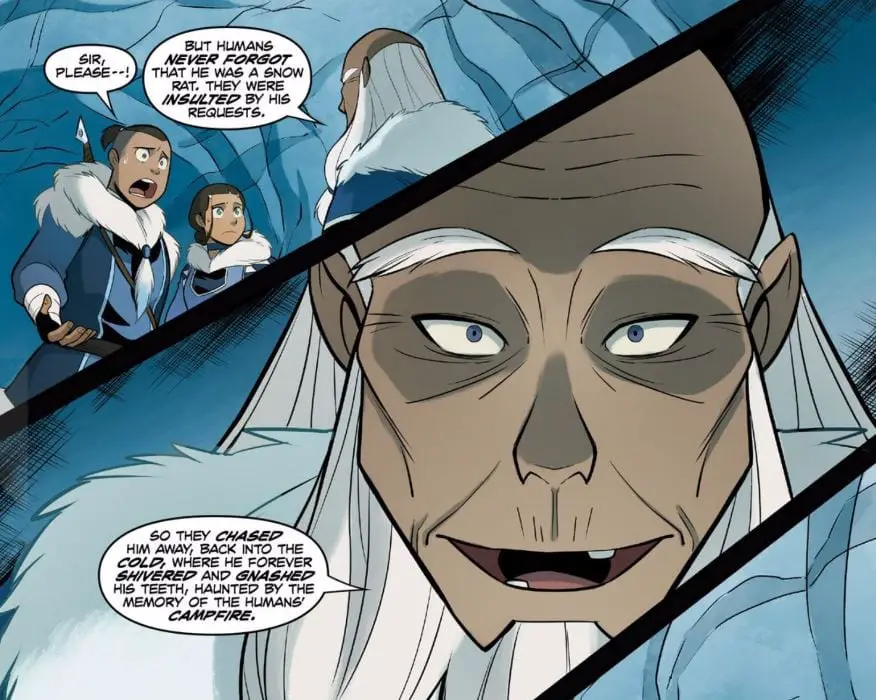
Oh.
Images courtesy of Dark Horse Comics and Nickelodeon
AVATAR: THE LAST AIRBENDER – NORTH AND SOUTH PART 2
Writer: Gene Luen Yang
Art: Gurihiru

